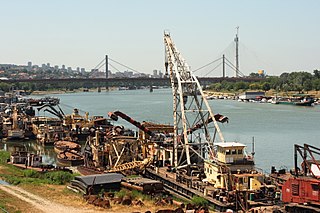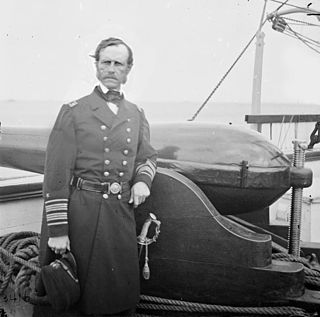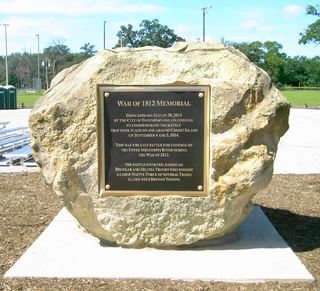
A ship of the line was a type of naval warship constructed during the Age of Sail from the 17th century to the mid-19th century. The ship of the line was designed for the naval tactic known as the line of battle, which involved the two columns of opposing warships manoeuvering to volley fire with the cannons along their broadsides. In conflicts where opposing ships were both able to fire from their broadsides, the faction with more cannons firing – and therefore more firepower – typically had an advantage.

CSS Albemarle was a steam-powered casemate ironclad ram of the Confederate Navy, named for an estuary in North Carolina which was named for General George Monck, the first Duke of Albemarle and one of the original Carolina Lords Proprietor.

A gunboat is a naval watercraft designed for the express purpose of carrying one or more guns to bombard coastal targets, as opposed to those military craft designed for naval warfare, or for ferrying troops or supplies.

USS Minnesota was a wooden steam frigate in the United States Navy. Launched in 1855 and commissioned eighteen months later, the ship served in east Asia for two years before being decommissioned. She was recommissioned at the outbreak of the American Civil War and returned to service as the flagship of the North Atlantic Blockading Squadron.

A pontoon bridge, also known as a floating bridge, uses floats or shallow-draft boats to support a continuous deck for pedestrian and vehicle travel. The buoyancy of the supports limits the maximum load that they can carry.

A riverboat is a watercraft designed for inland navigation on lakes, rivers, and artificial waterways. They are generally equipped and outfitted as work boats in one of the carrying trades, for freight or people transport, including luxury units constructed for entertainment enterprises, such as lake or harbour tour boats. As larger water craft, virtually all riverboats are especially designed and constructed, or alternatively, constructed with special-purpose features that optimize them as riverine or lake service craft, for instance, dredgers, survey boats, fisheries management craft, fireboats and law enforcement patrol craft.

The Battle of Sinop, or the Battle of Sinope, was a naval battle that took place on 30 November 1853 between Imperial Russia and the Ottoman Empire during the opening phase of the Crimean War (1853–1856). It took place at Sinop, a sea port on the southern shore of the Black Sea. A Russian squadron attacked and decisively defeated an Ottoman squadron anchored in Sinop's harbor. The Russian force consisted of six ships of the line, two frigates and three armed steamers, led by Admiral Pavel Nakhimov; the Ottoman defenders were seven frigates, three corvettes and two armed steamers, commanded by Vice Admiral Osman Pasha.

Joseph Trewavas was a Royal Navy sailor and a recipient of the Victoria Cross, the highest award for gallantry in the face of the enemy that can be awarded to British and Commonwealth forces.

Dahlgren guns were muzzle-loading naval gun designed by a United States Navy Rear Admiral John A. Dahlgren, mostly used in the American Civil War. Dahlgren's design philosophy evolved from an accidental explosion in 1849 of a 32 lb (14.5 kg) gun being tested for accuracy, killing a gunner. He believed a safer, more powerful naval cannon could be designed using more scientific design criteria. Dahlgren guns were designed with a smooth curved shape, equalizing strain and concentrating more weight of metal in the gun breech where the greatest pressure of expanding propellant gases needed to be met to keep the gun from bursting. Because of their rounded contours, Dahlgren guns were nicknamed "soda bottles", a shape which became their most identifiable characteristic.
The siege of Taganrog is a name given in some Russian histories to Anglo-French naval operations in the Sea of Azov between June and November 1855 during the Crimean War. British and French forces were implementing a strategy of destroying the supply lines for the main Russian army which ran through the Sea of Azov. Taganrog was one of the major logistical hubs of the Russian army and was attacked and its military depot destroyed on 3 June 1855 as part of a series of attacks on all major Russian supply bases in the area, except Rostov-on-Don, which could not be reached due to the large shoals not admitting any available warship.

Credit Island is an island in the Mississippi River on the south west side of Davenport, Iowa within the Quad Cities area. Its name was derived by the use of the island as an early Indian trading post. Credit could be obtained on the promise of hides and skins to be delivered at a later time, hence the name. It was listed on the Davenport Register of Historic Properties on February 3, 1999.

A pontoon boat is a flattish boat that relies on floats to remain buoyant. These pontoons contain much reserve buoyancy and allow designers to create large deck plans fitted with a variety of accommodations including expansive lounge areas, stand-up bars, and sun pads. More horsepower is now able to be applied to the stern due to design improvements. Pontoon boat drafts may be as shallow as eight inches, which reduces risk of running aground and underwater damage; this allows it to come close to shore to pick up and drop off loads.

John H Amos is a paddlewheel tugboat built in Scotland in 1931. The last paddlewheel tug built for private owners, now owned by the Medway Maritime Trust. She is one of only two surviving British-built paddle tugs, the other being Eppleton Hall preserved at the San Francisco Maritime National Historical Park in San Francisco, California.

The Battle of Doro Passage was a naval engagement during the United States Navy's operation against Greek pirates in the Aegean Sea. On October 16, 1827 a British merchant ship was attacked by pirates in Doro Passage off the islands of Andros and Negroponte but was retaken by American sailors.
The SS Ava was a 1,613 GRT British steamship, constructed in 1855 by the Tod & McGregor shipyard in Glasgow. Described as "an iron screw barque with one funnel", she was operated by the Peninsular & Oriental Steam Navigation Company on the China mail service and was named after Ava, the ancient capital of Burma. She ran aground and was wrecked off the coast of Ceylon in February 1858.

The Battle off Mukah was a naval engagement fought in May 1862 between boats of the Sarawak and pirates. After the kidnapping of Sarawakian citizens some time before, two small gunboats encountered the pirates off Mukah on the northern coast of Borneo. In an unusual action, the Rajah Muda, Captain John Brooke, then the heir apparent to be White Rajah of Sarawak, led his force in the defeat of six pirate ships and the rescue of captured civilians.

The Herald was an iron paddle steamer imported as frames from the United Kingdom and assembled in 1855 by Richard Johnson in Sydney Harbour, New South Wales, Australia, where she was registered. The Herald is one of the earliest iron paddle wheel steamers built in Australia, where she operated within Sydney Harbour. She was initially used on the fledgling North Shore route between Dawes Point and Blues Point by the newly formed North Shore Steam Company; however, due to not enough traffic to make her financially viable, she often performed tug duties. Eventually the North Shore Steam Company was wound up; the vessel was put up for sale but continued picking up business wherever it was available, operating as a tug, ferry, excursion boat and cargo vessel.
A line thrower is a device that casts a line to a remote position. It is used in rescues as well as marine operations. A line thrower may employ a variety of launching methods including guns, rockets, and pneumatics.

The S.S. Golden Gate was a mail and passenger steamer that operated between San Francisco and Panama City from 1851 to 1862. On its last voyage from San Francisco it caught fire and was destroyed with the loss of 204 lives off Manzanillo, Colima, Mexico. The ship was carrying $1,400,000 in gold coins for Wells Fargo, as well as large amounts of gold and coins for the passengers. Much of this was retrieved, but amateurs continue to search for gold with metal detectors on what is now called the Playa de Oro.